Pain Relief
Top 3 Natural Painkiller Plants
Looking for natural pain relief? Discover the powerful analgesic properties of turmeric, ginger, and peppermint in our top 3 painkiller plants list.

When it comes to natural pain relief, turmeric, ginger, and peppermint are our top choices for potent analgesic properties. Turmeric's active compound, curcumin, acts as a natural painkiller by reducing inflammation and offering antioxidant benefits. Ginger, with its gingerol content, effectively reduces muscle pain, soreness, and even symptoms of osteoarthritis. Peppermint, known for its menthol content, provides cooling pain relief by blocking pain signals and reducing pain sensitivity over time. These plants offer versatile and holistic pain management options for those seeking natural remedies.
Key Takeaways
- Turmeric's curcumin offers potent pain relief through anti-inflammatory and antioxidant properties.
- Ginger's gingerol acts as a natural analgesic, reducing muscle pain, arthritis symptoms, and migraines.
- Peppermint's menthol provides cooling pain relief by blocking pain signals and reducing sensitivity over time.
Turmeric: Potent Pain Relief
We find turmeric to be a potent pain reliever due to its active compound curcumin known for its anti-inflammatory properties. Curcumin, found in turmeric, acts as a natural analgesic by reducing inflammation, making it effective in alleviating joint pain, arthritis, and various inflammatory conditions.
The antioxidant properties of turmeric further enhance its pain-relieving abilities, providing a holistic approach to managing discomfort. Centuries of traditional medicine have recognized turmeric for its healing properties, attributing its efficacy in pain relief to its analgesic effects.
Incorporating turmeric into your daily routine, whether through culinary uses or supplements, can offer a natural alternative for pain management. The anti-inflammatory nature of curcumin not only targets pain symptoms but also addresses the underlying causes, promoting overall well-being.
Embracing turmeric as a natural painkiller can provide relief without the potential side effects associated with conventional medications, making it a valuable addition to a health-conscious lifestyle.
Ginger: Natural Analgesic
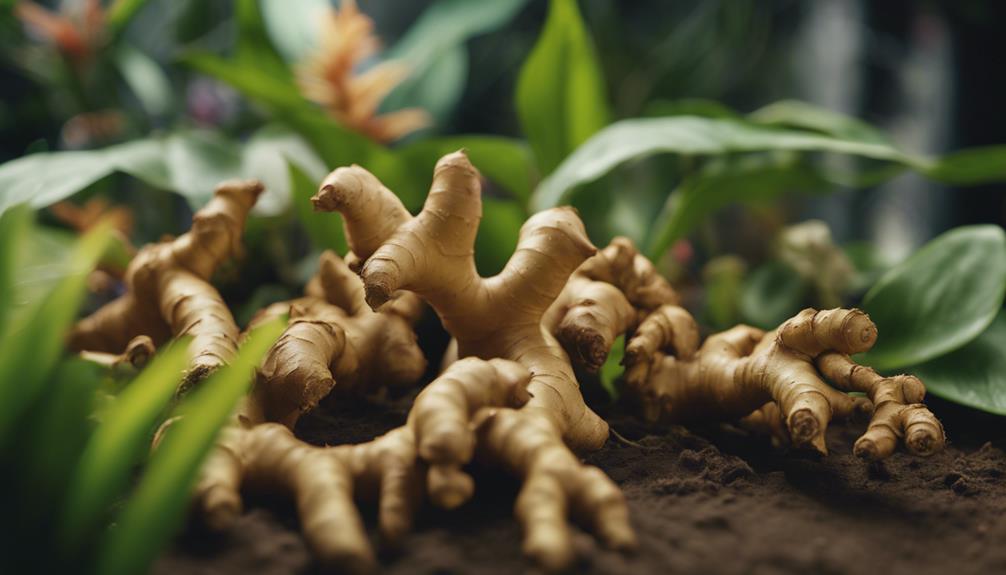
How does ginger serve as a natural analgesic for pain relief?
Ginger contains bioactive compounds like gingerol, known for their potent anti-inflammatory and analgesic properties. These properties make ginger an effective natural painkiller, particularly in reducing muscle pain and soreness.
Studies have indicated that regular consumption of ginger can help alleviate symptoms of conditions like osteoarthritis by decreasing pain and enhancing mobility.
The anti-inflammatory effects of ginger extend to providing relief for menstrual pain and migraines as well.
Whether consumed fresh, in powdered form, or as a supplement, ginger contributes to natural pain relief due to its diverse range of applications.
Its ability to target various types of pain, coupled with its anti-inflammatory nature, positions ginger as a versatile and accessible option for those seeking natural alternatives for pain management.
Peppermint: Cooling Pain Reliever

Peppermint stands out as a cooling pain reliever due to its unique ability to provide relief through its menthol content, which acts as a natural painkiller by blocking pain signals.
When applied topically, peppermint oil offers an invigorating cooling sensation that can help alleviate various types of discomfort, including headaches, muscle aches, and joint pain.
The menthol in peppermint not only provides immediate relief but also has been shown to reduce pain sensitivity over time. Studies support the analgesic properties of peppermint, making it a popular choice for those seeking natural pain management options.
By targeting pain at the source and offering a soothing effect, peppermint serves as a versatile remedy for individuals looking to address their pain in a more holistic manner.
Whether used alone or in combination with other natural pain relievers, peppermint continues to be a go-to solution for those seeking relief from various forms of discomfort.
Frequently Asked Questions
What Is the Strongest Natural Painkiller?
We believe wild lettuce is one of the strongest natural painkillers due to its pain-relieving properties. Lactucarium in wild lettuce contains compounds like lactucin and lactucopicrin, potentially offering pain relief comparable to ibuprofen.
What Plant Is the Best Pain Killer?
We believe wild lettuce stands out as a potential natural painkiller plant. Its lactucarium contains properties akin to ibuprofen. While research on its efficacy is limited, some components show anti-inflammatory effects, contributing to pain relief.
What Is the Strongest Herb for Nerve Pain?
For nerve pain relief, Wild Lettuce is a popular choice. Its lactucarium contains compounds that may help alleviate discomfort. More human studies are necessary to confirm its efficacy conclusively, but animal research looks promising.
Which Plant Is Traditionally Used as a Pain Reliever?
Wild Lettuce, traditionally used as a pain reliever, contains compounds that act on the central nervous system for relief. While research is limited, caution is advised due to potential side effects and lack of FDA regulation.
Conclusion
To sum up, turmeric, ginger, and peppermint stand as formidable allies in the battle against pain. Like a trio of skilled warriors, these natural painkiller plants offer potent relief without the harsh side effects of pharmaceuticals.
Turmeric's powerful anti-inflammatory properties, ginger's natural analgesic qualities, and peppermint's cooling sensation make them invaluable tools in the fight against discomfort. Incorporating these plants into your wellness routine can help you conquer pain and regain control of your health.

Pain Relief
Turmeric's Potent Relief for Osteoarthritis Pain
Journey towards a pain-free life with turmeric, a natural remedy that has been shown to effectively alleviate osteoarthritis symptoms.

Turmeric's potent anti-inflammatory compound, curcumin, has been shown to effectively alleviate osteoarthritis pain by blocking the production of pro-inflammatory molecules. In clinical trials, 70% of patients experienced improved joint function and reduced pain. Turmeric's antioxidant properties protect joint tissues, and its anti-inflammatory effects have been consistently demonstrated in clinical studies. By incorporating turmeric into daily life, individuals can harness its potent relief for osteoarthritis pain. As you explore the numerous ways to utilize turmeric, you'll discover the natural remedy's full potential for managing osteoarthritis symptoms.
Key Takeaways
• Turmeric's curcumin blocks pro-inflammatory molecules, reducing osteoarthritis symptoms and alleviating pain.
• Clinical trials show that turmeric improves joint function and reduces inflammation in osteoarthritis patients.
• Turmeric's antioxidant properties protect joint tissues, providing a natural remedy for managing osteoarthritis pain.
• Turmeric can be easily incorporated into daily life through food, supplements, or both, making it a versatile pain relief option.
• Turmeric's anti-inflammatory power has been scientifically proven, making it a potent natural solution for osteoarthritis pain relief.
Turmeric's Anti-Inflammatory Power
Turmeric's potent anti-inflammatory power stems from curcumin, which effectively blocks the production of pro-inflammatory molecules, thereby alleviating osteoarthritis symptoms.
By reducing inflammation, turmeric helps mitigate joint pain and improve mobility.
Clinical trials have consistently demonstrated turmeric's efficacy in reducing pain and improving joint function in osteoarthritis patients.
Additionally, turmeric's antioxidant properties protect joint tissues from oxidative damage, further contributing to its therapeutic benefits.
As a natural, safe, and well-tolerated alternative to traditional treatments, turmeric has gained recognition as a potential adjunct therapy for osteoarthritis management.
With its impressive anti-inflammatory profile, turmeric offers a promising solution for alleviating osteoarthritis symptoms and improving quality of life.
Scientific Basis for Relief

Researchers have pinpointed the molecular mechanisms underlying turmeric's potent anti-inflammatory effects, shedding light on its ability to alleviate osteoarthritis symptoms.
Turmeric's active compound, curcumin, inhibits pro-inflammatory molecules like cytokines and chemokines, thereby reducing inflammation. Additionally, curcumin modulates molecular pathways, such as NF-κB, essential in regulating the immune response.
By suppressing enzymes like COX-2 and lipoxygenase, turmeric reduces the production of inflammatory compounds. Clinical studies have demonstrated turmeric's anti-inflammatory effects, comparable to over-the-counter medications.
These scientific insights provide a solid foundation for turmeric's role in alleviating osteoarthritis pain, making it a promising natural remedy for managing this debilitating condition.
Safety Precautions and Considerations

It's important to be aware of potential gastrointestinal issues that can arise from high doses of turmeric, even though it's generally considered safe. Turmeric can cause stomach upset, nausea, and diarrhea in some individuals, especially when consumed in high amounts.
Additionally, turmeric may interact with certain medications, such as blood thinners and diabetes drugs, which can lead to adverse effects.
Consult a healthcare provider before incorporating turmeric supplements, especially if taking medications or having underlying health conditions.
Start with a low dose and gradually increase as needed and under medical supervision.
Be cautious when combining turmeric with other herbal supplements or medications.
Monitor your body's response to turmeric and adjust dosage or discontinue use if adverse effects occur.
Incorporating Turmeric Into Daily Life

By incorporating turmeric into their daily routine, individuals can experience the natural anti-inflammatory benefits that support osteoarthritis pain relief. This can be achieved by adding turmeric to various dishes, such as curries, soups, smoothies, and teas.
For those who prefer supplements, curcumin capsules are available. Scientific research has consistently demonstrated turmeric's efficacy in managing osteoarthritis symptoms. By making turmeric a part of their daily regimen, individuals can harness its potent anti-inflammatory properties to alleviate osteoarthritis pain.
With its versatility and ease of incorporation, turmeric is an excellent addition to a holistic approach to osteoarthritis management.
Real-World Applications and Benefits

Turmeric's versatility in cooking and supplement forms has led to its widespread adoption in managing osteoarthritis symptoms in everyday life. Its incorporation into daily life is effortless, and the benefits are undeniable. Whether added to dishes, consumed as a supplement, or used in topical applications, turmeric's curcumin content provides potent relief from osteoarthritis pain.
- Imagine sipping on a warm turmeric latte to start your day, feeling the anti-inflammatory effects coursing through your body.
- Picture adding a pinch of turmeric to your favorite curry recipe, reaping the benefits with every bite.
- Envision taking a turmeric supplement with piperine for enhanced absorption, knowing you're taking control of your osteoarthritis symptoms.
- Visualize incorporating turmeric into your self-care routine, feeling empowered to manage your osteoarthritis pain naturally.
Frequently Asked Questions
Can I Take Turmeric if I Have a Bleeding Disorder or Take Blood Thinners?
She should exercise caution when considering turmeric supplements if she has a bleeding disorder or takes blood thinners, as turmeric can increase the risk of bleeding.
Turmeric's anti-platelet properties may interact with medications, so it's crucial to consult a healthcare provider before adding turmeric to her regimen.
They can help her weigh the benefits against the potential risks and guarantee safe integration.
How Long Does It Take to Experience Relief From Osteoarthritis Symptoms?
It's not a miracle, but it may feel like one: relief from osteoarthritis symptoms can be experienced in as little as a few weeks to a few months of consistent turmeric consumption. Clinical trials suggest that curcumin, the active compound in turmeric, can reduce pain and improve joint function within 2-3 months.
However, individual results may vary, and it's important to consult a healthcare provider to determine the best treatment plan.
Can Turmeric Be Used in Combination With Prescription Medications?
She can use turmeric in combination with prescription medications, but it's important to consult a healthcare provider first.
Turmeric may interact with medications like blood thinners and diabetes drugs, so it's vital to discuss potential interactions.
As a precaution, it's recommended to start with a low dose and monitor its effects.
Are There Any Specific Turmeric Supplements Recommended for Osteoarthritis?
Prior to selecting a turmeric supplement for osteoarthritis, she looks for products containing a bioavailable curcumin extract, standardized to 95% curcuminoids.
Additionally, piperine, a black pepper extract, is often combined with turmeric to enhance absorption.
According to experts, a daily dose of 500-2000mg of curcumin is recommended.
Prior consultation with a healthcare provider is crucial before starting any supplement regimen, especially when combined with prescription medications.
Can I Use Fresh Turmeric Roots Instead of Ground Turmeric Powder?
She can use fresh turmeric roots as an alternative to ground turmeric powder.
Fresh turmeric roots contain a higher concentration of curcuminoids, the active compounds responsible for turmeric's anti-inflammatory properties.
However, fresh turmeric roots have a shorter shelf life and require proper storage to maintain potency.
Additionally, the bioavailability of curcuminoids from fresh roots may vary depending on individual digestive systems, emphasizing the importance of consulting a healthcare provider for personalized guidance.
Conclusion
As the golden hue of turmeric illuminates the path to osteoarthritis relief, its potent anti-inflammatory properties shine brighter than ever.
With scientific evidence backing its efficacy, turmeric emerges as a beacon of hope for millions worldwide.
As we weave this ancient spice into the fabric of our daily lives, we can envision a future where joints move with ease, pain subsides, and the burden of osteoarthritis is alleviated.
By harnessing turmeric's therapeutic potential, we may reveal a life free from debilitating pain, where every step is a step towards freedom.
Pain Relief
Golden Herb Turmeric: Anti-Inflammatory Powerhouse
Boost your health by unlocking the secrets of turmeric, a potent anti-inflammatory powerhouse with scientifically-backed benefits waiting to be discovered.

Turmeric, a vibrant yellow spice, has been revered for centuries for its extraordinary anti-inflammatory properties, rooted in its rich curcumin content. As a potent compound, curcumin has been extensively studied and proven to effectively reduce both acute and chronic inflammation. Turmeric modulates inflammatory pathways, making it a valuable natural remedy for inflammation management. To maximize its benefits, understanding bioavailability optimization is essential, and combining it with ginger amplifies its anti-inflammatory effects. As research validates turmeric's efficacy, incorporating it into one's diet can have a profound impact on inflammation management; and exploring further reveals the full potential of this golden herb.
Key Takeaways
• Turmeric's potent anti-inflammatory compound curcumin reduces acute and chronic inflammation by modulating inflammatory pathways.
• Combining turmeric with black pepper, olive oil, or ginger enhances curcumin absorption and bioavailability.
• Turmeric can be easily incorporated into one's diet through various recipes, smoothies, or supplements, catering to individual preferences.
• Turmeric and ginger have a synergistic effect, amplifying each other's anti-inflammatory effects and providing a profound response.
• Curcumin's anti-inflammatory mechanisms include suppressing pro-inflammatory enzymes, inhibiting NF-κB activation, and reducing oxidative stress.
Turmeric's Anti-Inflammatory Potency
Turmeric's vibrant yellow color is a reflection of its rich content of curcumin, a potent anti-inflammatory compound that has been extensively studied for its ability to effectively reduce both acute and chronic inflammation in various chronic diseases.
Curcumin's anti-inflammatory effects have been well-documented and recognized for their medicinal properties. Turmeric's ability to modulate inflammatory pathways makes it a valuable natural remedy for inflammation management.
The anti-inflammatory potency of turmeric, especially curcumin, has been demonstrated in numerous studies, showcasing its potential in alleviating symptoms of chronic diseases.
As a natural anti-inflammatory agent, turmeric offers a promising solution for managing inflammation, making it a valuable addition to a healthy lifestyle.
Enhancing Turmeric's Bioavailability

Combining turmeric with black pepper, which contains piperine, can greatly enhance curcumin absorption, with some studies suggesting an increase of up to 2,000%. This potent combination is a game-changer for maximizing turmeric's anti-inflammatory benefits.
| Turmeric Pairing | Bioavailability Boost | Reason |
|---|---|---|
| Black Pepper | 2,000% | Piperine enhances curcumin absorption |
| Olive Oil | 7-8 fold | Curcumin is fat-soluble, absorbs better with fats |
| Ginger | Synergistic effect | Complementary mechanisms of curcumin and gingerols |
Proper consumption methods that enhance bioavailability are essential for maximizing turmeric's anti-inflammatory benefits. By understanding how to optimize turmeric's absorption, individuals can leverage its full potential in reducing inflammation and promoting overall well-being.
Incorporating Turmeric Into Your Diet
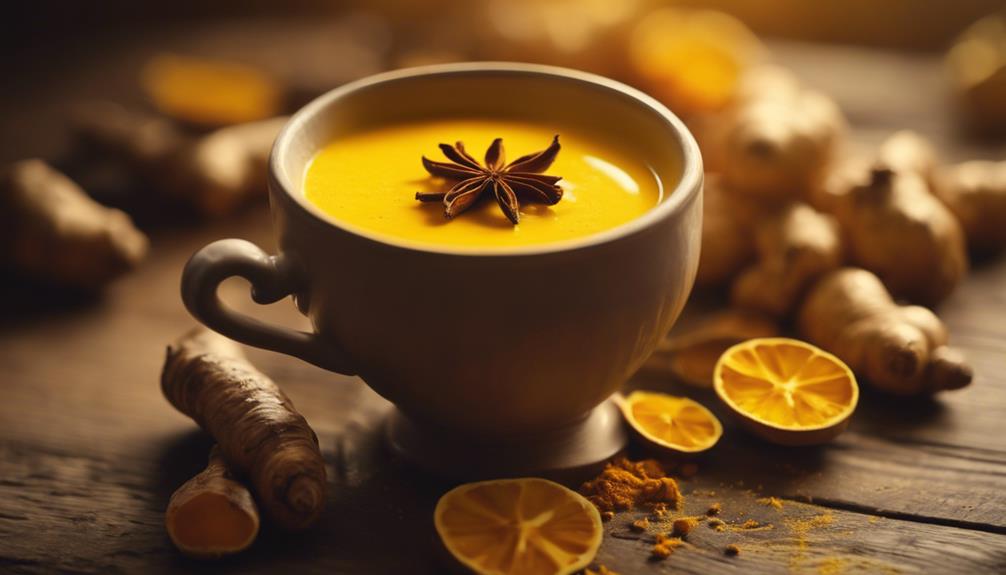
With its vibrant yellow color and versatility in recipes, turmeric can be easily incorporated into a daily diet to reap its anti-inflammatory benefits.
Turmeric can be added to various dishes, such as roasted vegetables, rice, or smoothies, making it a convenient way to incorporate its anti-inflammatory properties.
Another option is to make turmeric lattes or consume curcumin supplements for a consistent intake.
Turmeric's versatility offers multiple options for consumption, catering to individual preferences.
Clinical studies have validated the efficacy of turmeric in reducing inflammation-related symptoms in conditions like osteoarthritis and inflammatory bowel disease.
Synergistic Potential of Turmeric and Ginger
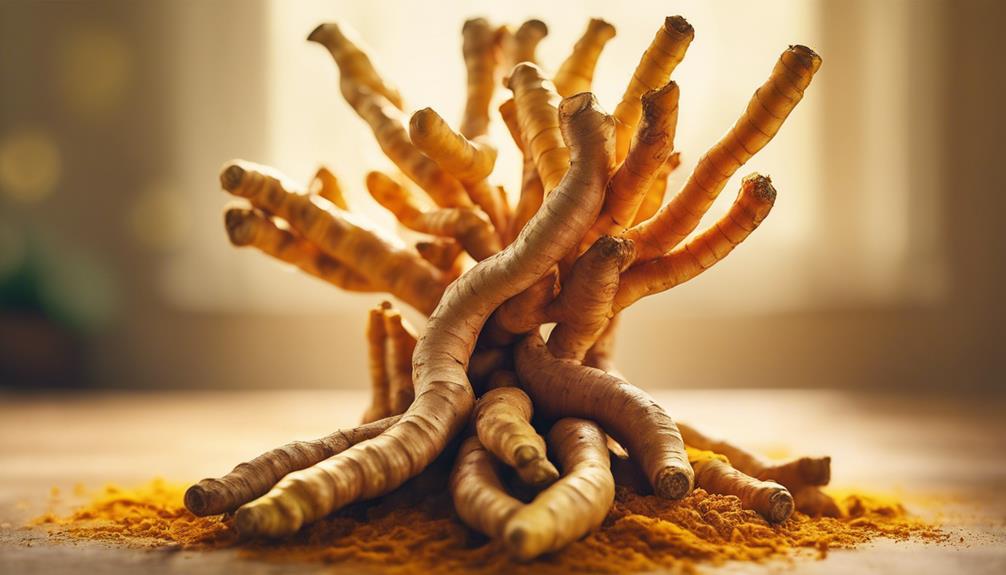
Frequently, the anti-inflammatory effects of turmeric are amplified when paired with ginger, its complementary counterpart in the botanical world. The synergistic potential of these two roots is rooted in their distinct yet complementary mechanisms.
Turmeric's curcumin and ginger's gingerols work in tandem to produce a more profound anti-inflammatory response. This potent duo can be consumed fresh, dried, or powdered, and balanced dosage supplements are available.
Scientific evidence supports the use of turmeric and ginger for their anti-inflammatory properties, offering a holistic approach to inflammation management. By combining these two roots, individuals can maximize the benefits of their anti-inflammatory effects, providing a natural and effective way to manage inflammation-related symptoms.
Turmeric's Inflammation-Fighting Mechanisms

Turmeric's potent anti-inflammatory effects are mediated by curcumin, which suppresses the production of pro-inflammatory enzymes and cytokines, thereby blocking the inflammatory cascade.
Curcumin's anti-inflammatory mechanisms involve inhibiting the activation of nuclear factor kappa B (NF-κB), a transcription factor that regulates pro-inflammatory genes.
In addition, curcumin downregulates the expression of cyclooxygenase-2 (COX-2), an enzyme involved in prostaglandin production, which contributes to inflammation.
Moreover, curcumin's antioxidant properties neutralize free radicals, reducing oxidative stress and inflammation.
These mechanisms collectively contribute to turmeric's anti-inflammatory potency, making it a valuable natural remedy for managing inflammation-related disorders.
Research has consistently demonstrated curcumin's efficacy in reducing inflammation and alleviating symptoms in various chronic diseases.
Safe and Effective Usage Guidelines
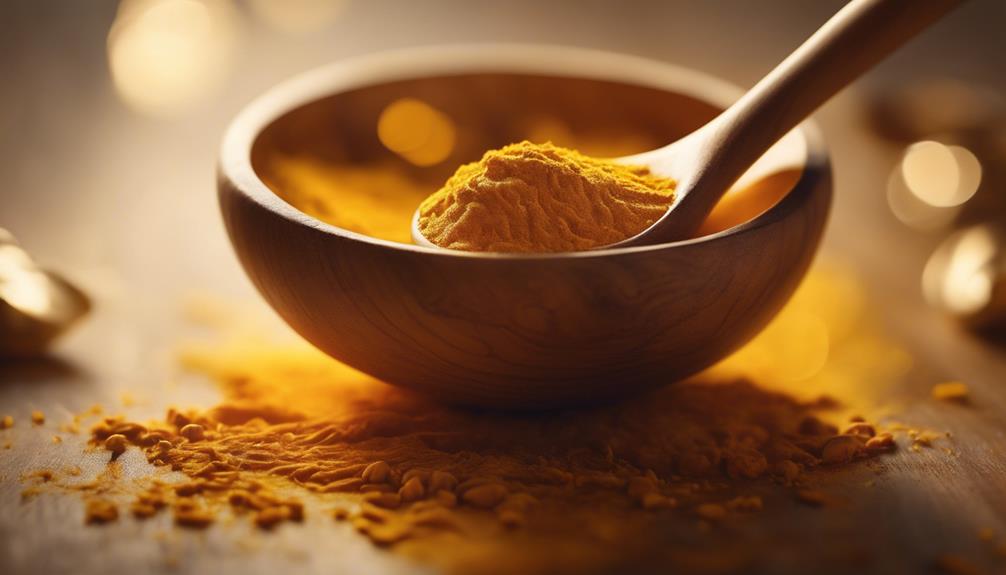
To harness the full benefits of turmeric while minimizing adverse effects, individuals should consult with a healthcare professional before starting a high-dose turmeric regimen, especially for those taking medications or having underlying health conditions. Turmeric can interact with blood thinners, diabetes medications, and blood pressure medications, so caution is advised.
The recommended daily dosage of turmeric varies from 500mg to 2,000mg, depending on the individual's health goals and needs. Additionally, taking turmeric with black pepper and fat can enhance bioavailability.
Maximizing Turmeric's Health Benefits

To fully tap into the full potential of turmeric, it's important to comprehend how to maximize its health benefits, and combining it with other anti-inflammatory compounds is a great starting point.
Curcumin, the active compound in turmeric, has limited bioavailability, but pairing it with piperine, a natural compound found in black pepper, can enhance absorption by up to 2,000%. Additionally, consuming turmeric with fats like olive oil can improve bioavailability.
Moreover, incorporating turmeric into daily routines through teas, smoothies, or soups can provide a convenient way to reap its anti-inflammatory benefits. By understanding how to maximize turmeric's health benefits, individuals can utilize its full potential and effectively manage inflammation.
Frequently Asked Questions
Can I Consume Turmeric if I'm Taking Blood Thinners or Diabetes Medications?
When taking blood thinners or diabetes medications, it's important to exercise caution when consuming turmeric. Turmeric's active compound, curcumin, can interact with these medications, increasing the risk of bleeding or altering blood sugar levels.
As a precaution, individuals should consult their healthcare professionals before adding turmeric to their regimen, as they can help determine safe dosage and potential interactions.
How Long Does It Take to Notice the Anti-Inflammatory Effects of Turmeric?
When consuming turmeric, it typically takes 4-8 weeks to notice the anti-inflammatory effects. This timeframe can vary depending on individual factors, such as dosage, bioavailability, and health conditions.
According to a study published in the Journal of Medicinal Food, 'curcumin supplementation for 4-6 weeks reduced inflammatory biomarkers in patients with metabolic syndrome.'
Consistency and patience are key to experiencing the full benefits of turmeric's anti-inflammatory properties.
Are There Any Known Interactions Between Turmeric and Hormonal Birth Control?
She explores the potential interactions between turmeric and hormonal birth control, an important consideration for women using both. Research suggests that curcumin may increase the risk of bleeding in individuals taking hormonal contraceptives, such as the pill, patch, or ring.
However, no conclusive evidence exists, and more studies are needed to fully understand the effects of this combination. It's essential for women to consult their healthcare provider before adding turmeric supplements to their regimen while using hormonal birth control.
Can I Give Turmeric to My Children for Inflammation and Pain Relief?
When considering turmeric for children's inflammation and pain relief, parents should consult a pediatrician first. Turmeric's active compound, curcumin, is generally recognized as safe for children, but dosage and preparation guidelines vary.
According to the National Institute of Health, 'turmeric is possibly safe for children when used in amounts commonly found in food.' However, high doses may interact with medications, so seeking guidance from a healthcare professional is essential to guarantee safe and effective use.
Can I Use Turmeric Essential Oil Topically for Skin Inflammation and Wounds?
As turmeric's golden essence wafts into the world of skin care, an important question arises: can turmeric essential oil be used topically for skin inflammation and wounds? According to experts, yes, but with caution.
Turmeric essential oil contains sesquiterpenes and turmerones, which have anti-inflammatory and antioxidant properties. However, it's necessary to dilute the oil in a carrier oil and perform a patch test to avoid skin irritation.
Conclusion
In summary, turmeric's golden hue belies its powerful anti-inflammatory prowess, illuminating a path to mitigating chronic diseases.
As research continues to uncover its secrets, this ancient herb emerges as a shining star in the field of natural remedies, its potent curcumin content waiting to be harnessed through strategic consumption methods and synergistic pairings.
As we maximize the full potential of turmeric, a brighter future beckons, where inflammation's dark shadow is overshadowed by the radiant glow of excellent health.
Pain Relief
Effective Herbs for Soothing Nerve Pain
Naturopathic remedies offer a beacon of hope for neuropathic pain sufferers, but which herbs will bring the most relief?

For individuals struggling with neuropathic pain, certain herbs have shown significant promise in alleviating discomfort and inflammation associated with nerve damage. St. John's Wort, known for its antidepressant properties, and turmeric, containing anti-inflammatory curcumin, are effective in reducing pain. Passionflower, a natural sedative, and ginger, with its anti-inflammatory properties, also provide relief. Valerian root, a natural muscle relaxant, can help with pain management. To maximize the benefits of these herbs, it's essential to understand how to incorporate them effectively, considering individual needs, health status, and medication interactions, and by doing so, individuals can find much-needed relief from nerve pain. Further guidance on strategic herbal integration can lead to even greater success.
Key Takeaways
• St. John's Wort is known for its antidepressant properties, which can help alleviate nerve pain symptoms.
• Turmeric contains curcumin, which has potent anti-inflammatory properties that can reduce nerve pain and inflammation.
• Passionflower is a natural sedative that can help reduce anxiety and promote relaxation, providing relief from nerve pain.
• Ginger has anti-inflammatory properties that can help reduce pain and inflammation associated with nerve pain.
• Valerian root is a natural muscle relaxant that can help relieve nerve pain by reducing muscle tension and promoting relaxation.
Understanding Nerve Pain Basics
Nerve pain, also known as neuropathy, occurs when damaged nerves disrupt the normal transmission of signals between the brain and the rest of the body. This disruption can lead to a range of uncomfortable and painful symptoms.
Damaged nerves can be caused by various factors, including diabetes, injuries, infections, autoimmune diseases, and chemotherapy. Understanding the diverse causes of nerve pain is essential for effective management and treatment.
Recognizing Nerve Pain Symptoms

Symptoms of nerve damage can manifest in a variety of ways, often starting with subtle sensations that can escalate into debilitating pain if left untreated. Recognizing these symptoms is essential for effective management of nerve pain.
- Tingling or numbness in hands and feet
- Sharp, stabbing, or burning pain
- Muscle weakness or lack of coordination
- Hyperalgesia or increased sensitivity to pain
- Abnormal sensations, such as feeling of wearing gloves or socks when none are present
Managing Nerve Pain Strategies

By combining medicinal therapies with lifestyle modifications and alternative treatments, individuals can develop a holistic approach to managing nerve pain.
Medicinal therapies, such as anticonvulsants and antidepressants, can alleviate nerve pain.
Lifestyle modifications, including balanced blood sugar levels and regular exercise, can also help.
Alternative treatments like acupuncture and massage therapy have shown positive results in reducing nerve pain.
Early diagnosis is essential for effective management of nerve pain.
A thorough treatment plan should include a combination of these strategies to provide maximum relief.
Natural Herbs for Nerve Relief

Incorporating natural herbs into a holistic treatment plan can provide significant relief from nerve pain, and several herbs have shown remarkable efficacy in alleviating discomfort. These natural remedies can be used in conjunction with conventional treatments to enhance their effectiveness. Herbs have been used for centuries to address various health concerns, and their potential in nerve pain management is substantial.
Some of the most effective herbs for nerve relief include:
- St. John's Wort: Known for its antidepressant properties, it can help alleviate nerve pain symptoms.
- Turmeric: Contains curcumin, a potent anti-inflammatory compound that reduces pain and inflammation.
- Passionflower: A natural sedative that can help reduce anxiety and promote relaxation, alleviating nerve pain.
- Ginger: Possesses anti-inflammatory properties that can help reduce pain and inflammation.
- Valerian root: A natural muscle relaxant that can help reduce nerve pain and promote better sleep.
Using Herbs for Nerve Pain

While the previous herbs mentioned have shown remarkable efficacy in alleviating nerve pain, understanding how to effectively incorporate them into a holistic treatment plan is vital for the best relief. To maximize the benefits of herbal remedies, it is important to take into account individual needs, health status, and potential interactions with medications. A well-planned approach can lead to the best results.
| Herbal Remedy | Administration Methods |
|---|---|
| Turmeric | Capsules, tea, or topical application |
| Passionflower | Tea, tincture, or capsules |
| Ginger | Raw, cooked, or in supplement form |
| Valerian Root | Tea, capsules, or topical application |
| St. John's Wort | Capsules, tea, or tincture |
Frequently Asked Questions
Can Herbal Remedies Interact With Prescription Medications for Nerve Pain?
When exploring herbal remedies for nerve pain, it's important to take into account potential interactions with prescription medications.
Herbal supplements can interact with medications, amplifying or reducing their effects. For instance, St. John's Wort can decrease the efficacy of antidepressants, while turmeric may enhance the effects of blood thinners.
It's vital to consult with a healthcare provider before combining herbal remedies with prescription medications to guarantee safe and effective management of nerve pain.
Are There Any Herbal Remedies Suitable for Children With Nerve Pain?
When it comes to children with nerve pain, parents often wonder if herbal remedies are suitable for their little ones. The answer is, it depends.
While some herbs like chamomile and lavender oil have calming effects, others like St. John's Wort and passionflower may interact with medications or have side effects.
It's essential for parents to consult with their child's healthcare provider before using herbal remedies, as dosage and interactions vary greatly.
How Long Does It Take for Herbal Remedies to Show Nerve Pain Relief?
It's a wild misconception that herbal remedies work overnight, but the reality is that it takes time and patience. Typically, it can take anywhere from a few days to several weeks to notice significant nerve pain relief from herbal remedies.
According to a study published in the Journal of Pain Research, 'the analgesic effects of herbal remedies can take up to 4-6 weeks to manifest.'
Can Herbal Remedies Be Used in Conjunction With Traditional Medicine?
She can combine herbal remedies with traditional medicine, but it's important to consult with a healthcare provider first. This guarantees safe interactions and maximum relief from nerve pain.
According to the National Institute of Neurological Disorders and Stroke, 'herbal remedies can interact with prescription medications, including those for nerve pain.' By doing so, individuals can harness the benefits of both approaches, minimizing potential risks and maximizing pain relief.
Are There Any Herbal Remedies That Can Worsen Nerve Pain Symptoms?
According to the National Institute of Neurological Disorders and Stroke, approximately 20 million people in the United States experience neuropathic pain.
Some herbal remedies, although generally safe, can worsen nerve pain symptoms in certain individuals. For instance, ginkgo biloba can interact with blood thinners, exacerbating bleeding risks, while St. John's Wort can reduce the efficacy of medications, including those for nerve pain.
It's essential to consult a healthcare provider before incorporating herbal remedies into one's treatment plan.
Conclusion
To sum up, herbal remedies have emerged as a promising solution for alleviating nerve pain, with a growing body of scientific evidence supporting their efficacy.
According to the National Institutes of Health, approximately 10% of Americans suffer from neuropathic pain, highlighting the urgent need for effective treatment options.
By incorporating herbs such as St. John's Wort, turmeric, and others into daily life, individuals can find significant relief from the debilitating symptoms of nerve pain, improving their overall quality of life.
-

 Herbalism2 months ago
Herbalism2 months agoDoes Herbalism Actually Work?
-

 Anti Aging2 months ago
Anti Aging2 months agoMost Effective Anti-Aging Drink: 5 Top Picks
-

 Anti Aging2 months ago
Anti Aging2 months agoWhich Tea Increases Lifespan?
-

 Bone Health2 months ago
Bone Health2 months agoHerbal Secrets Unleashed: Boost Bone Density
-

 Anti Aging2 months ago
Anti Aging2 months agoThe Immortal Herb: Unveiling Its Special Qualities
-

 Anti Aging1 month ago
Anti Aging1 month agoAstragalus: The Ultimate Anti-Aging Herb
-
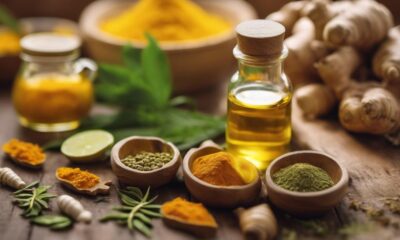
 Inflammation Management2 months ago
Inflammation Management2 months agoBest Natural Medicines for Joint Inflammation Relief
-
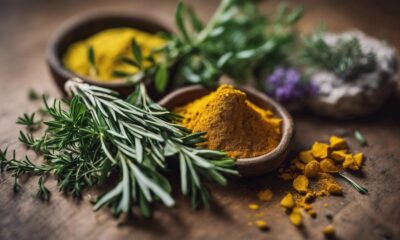
 Mental Health2 months ago
Mental Health2 months agoBest Herbs for Boosting Brain Health

















